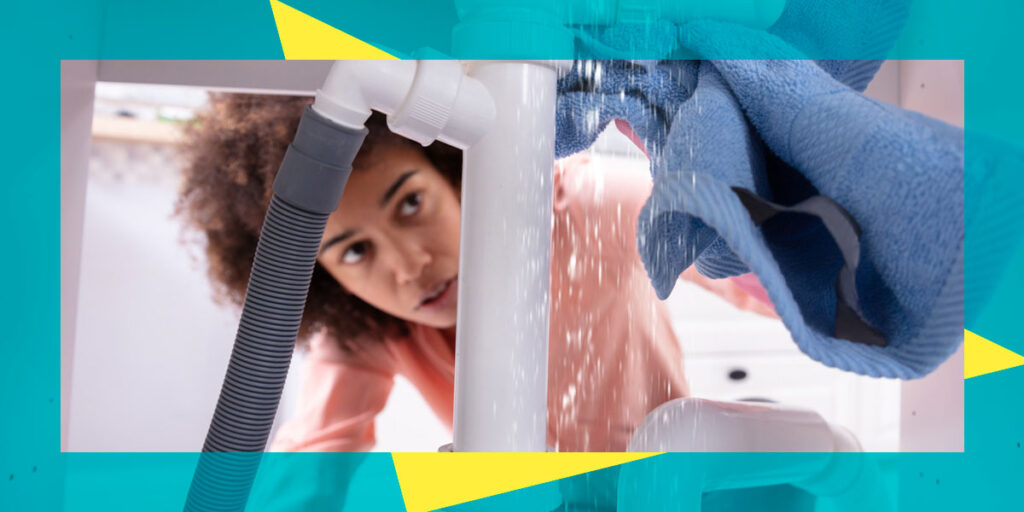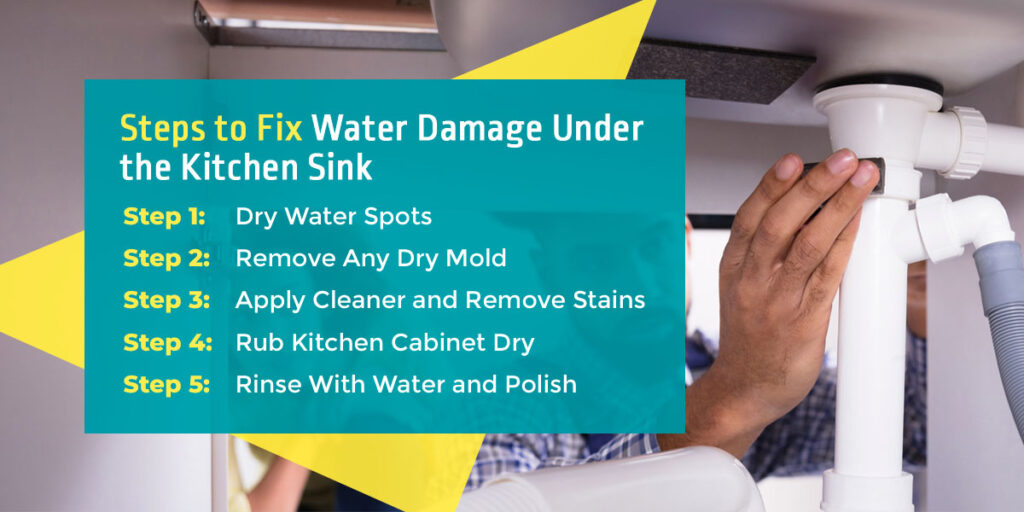How to Fix Water Damage Under the Kitchen Sink
Updated: June 21, 2024

Water damage under the kitchen sink is a common problem for homeowners. Fortunately, fixing the damage is easier than you think. Slight damage can be fixed at home quickly on a weekend afternoon. With the right tools — that you can commonly find in your house — you can restore damaged kitchen cabinets. If the water damage is more extensive, then you can try the steps below, but you might be better off just replacing the cabinets altogether or hiring a professional to quickly and efficiently remove and clean your damaged materials.
In this comprehensive guide, we'll help you identify the signs of water damage and locate the cause before exploring the steps to restore your cabinets.
Identifying Water Damage
Before you fix or replace your kitchen cabinets, you should identify the signs of water damage. If the damage is caused by another issue, you might end up needing to fix or replace your cabinets again at a later stage.
Discoloration is one of the most noticeable signs of water damage to look for. Moisture and heat are a common cause of discolored kitchen cabinets. If your kitchen cabinets are white, you'll notice brown stains easily. But if your cabinets are a darker color, you might need to inspect the surface more carefully to look for darker stained areas.
Water damage can also cause the cabinet material to warp. You might notice bubbles on the surface and the cabinet may swell in some areas as the water build-up causes the material to expand. Any signs of an uneven surface may be the result of water damage.
A musty smell often accompanies water damage below the kitchen sink, as the moisture fosters an ideal environment for mold and mildew. Even without significant warping and discoloration, a small, unnoticeable leak can lead to mold and mildew growth. Musty odor and visible mold are signs of extended water exposure and require prompt attention.
Potential Causes of Water Damage
When water damage sets in, the most common cause is a leak. Still, you'll need to identify the source of the leak to solve the problem before restoring your cabinets.
Inspect the following areas to identify the source of the leak:
- Sink drain: Water can overflow into the cabinet if the sink doesn't drain properly. A blocked drain could be the culprit. However, a leak can also occur if the joint connections in the drain line are loose or damaged.
- Leaky faucet: Wear and tear and loose connections can cause a faucet to leak. Open the faucet and look for signs of a leak while the water runs. Inspect the water supply line below the sink to spot dripping or moisture build-up.
- Old sealant: The sealant around the sink edges and the bottom of the faucet provides a water-tight seal. Silicone sealant can wear down over time and become less effective. Incorrect application techniques and the wrong type of sealant can also result in an ineffective seal. If the sealant is pulling away, there could be a break in the bond. Even the slightest break in the sealant can let water seep into the cabinet below.
- Dishwasher drain lines: Water supply and drain lines for dishwashers are often under the kitchen sink. The drain pipe might have moved out of the drain line, causing a leak. If the drain pipe is not positioned far enough into the drain line, water can fill up and spill over when the dishwasher drains.
- Washing machine drain lines: In some homes, the washing machine drain lines are installed below the kitchen sink. Over time, the machine's vibrations can wiggle the drain pipe out of position, resulting in a leak. If this is the cause of your leak, you might notice dripping sounds when your washing machine is draining. If the pipe has wiggled quite far out of the drain line, you'll hear water gushing and puddles spilling from your cabinet when the machine drains.
- Burst pipe: Water build-up below your kitchen sink can also be the result of a burst pipe. If this is the cause, you may notice a change in water pressure. If a burst pipe is causing water damage, it's best to reach out to a professional plumber.

Steps to Fix Water Damage Under the Kitchen Sink
To fix the water damage under your kitchen sink, you’ll need the following items:
- Dry cloths and sponges
- Hair dryer
- Bleach
- Ammonia
- Toothpaste and baking soda
- Mayonnaise and cigarette ashes
- Steel wool and mineral oil
- Polish
Step 1: Dry Water Spots
Before beginning any work under your kitchen sink, remove any cleaning bottles, garbage or clutter from the area. Then, take a dry cloth and soak up any visible pooling underneath your sink. Once the excess water is gone, use your hairdryer to dry up even more water. Set your blow dryer on its lowest setting, then hold it above the water spot by about nine inches. After about three minutes, this spot should be dry. Repeat this step for the remaining water spots. If you have extensive damage, you can guide your hairdryer in even lines to dry an entire area versus small spots.
Step 2: Remove Any Dry Mold
With flood damage comes mold. Depending on the severity of the mold, you may be able to follow these steps in order to remove the mold yourself -
- To remove mold under your kitchen sink, dampen a sponge with bleach and water.
- Wear a mask that covers your nose and mouth.
- Scrub hard at the dry mold until it is gone. A benefit to using bleach is that it removes the mold and disinfects the area, keeping it safer for you and your family.
Mold is a huge safety hazard. Mold spores may be nearly invisible to the naked eye and are very easily displaced, causing the air to be contaminated during your cleaning process. It is essential to wear a mask over your nose and mouth. It's highly recommended to use professional mold remediation to eliminate mold from your home. If the spores spread through the air, it could cause even more damage, resulting in higher expenses.
Step 3: Apply Cleaner and Remove Stains
Next, you’ll want to clean the areas affected by the water damage. A common household cleaner you can use for this task is ammonia. Wet another dry cloth and scrub away the water damage under the sink.
If you prefer home remedies to clean your house, you can make a paste with a few commonly found items. One option is to mix toothpaste and baking soda. You can also create a paste by mixing cigarette ashes and mayonnaise. Apply either of these pastes to the affected area and let sit for 25 minutes.
If the options above aren’t working for you, use a stronger solution of mineral oil and scrub the area with steel wool.
Step 4: Rub Kitchen Cabinet Dry
Once you’ve applied the cleaner and allowed it to sit, take a dry cloth and rub it away. Rub your dry cloth in a circular motion to remove the cleanser and lift the water stains.
Step 5: Rinse With Water and Polish
Now that the cleaner is cleared away, you can wipe down your cabinet floor with a damp cloth to remove any residues. To make your kitchen cabinet look new again, use furniture polish to give it a fresh sheen.
If you still notice damage you can’t live with at the end of this process, call a professional to clear the damage for you. A benefit to hiring a professional is the speed with which they remove the water staining and the industrial-grade cleaning agents they use that are much more powerful than the average home cleaning products.
Fast and Friendly Water Restoration Service in Chicago
If you’re a resident of the Chicago, IL, area, then let the professionals at ServiceMaster of Lincoln Park help you with your home cleaning needs. We offer a full range of services and specialize in water damage restoration. Our service range includes expert mold and mildew remediation and flooring and duct cleaning. Because home disasters don't occur on schedule, we also offer 24-hour emergency restoration services for all our customers. To restore peace of mind in your home, give us a call today at 773-346-6767 or fill out our online scheduling form.



Comments are closed.